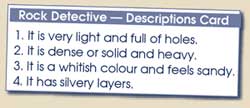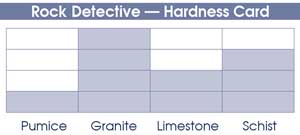|
|||||||||||||
|
|||||||||||||
%
responses 2007 ('03) |
|||||||||||||
y8 |
|||||||||||||
 In this activity you will be describing some rocks In this activity you will be describing some rocks and thinking about how they could have been formed. Here are four rocks. Pick them up to see what they are like. [Click on graphics to enlarge.] Hand out rocks. |
|||||||||||||
 1. Here are some words to describe these rocks. 1. Here are some words to describe these rocks.I want you to match the rocks with these descriptions. Place descriptions card in front of student and read the descriptions to the student. |
|||||||||||||
| Description 1: | D - Pumice |
99 (100) |
|||||||||||
| Description 2: | A - Granite |
52 (60) |
|||||||||||
| Description 3: | B - Limestone |
94 (93) |
|||||||||||
| Description 4: | C - Schist |
58 (68) |
|||||||||||
 Now you are going to try and work out the names of the rocks using this graph. The graph shows how hard the different rocks are. The rocks are pumice, granite, limestone and schist. Now you are going to try and work out the names of the rocks using this graph. The graph shows how hard the different rocks are. The rocks are pumice, granite, limestone and schist.Hand out graph. |
|||||||||||||
| 2. Which rock do you think is pumice? |
D |
95 (95) |
|||||||||||
| 3. Which rock do you think is granite? |
A |
40 (52) |
|||||||||||
| 4. Which rock do you think is limestone? |
B |
57 (55) |
|||||||||||
| 5. Which rock do you think is schist? |
C |
34 (37) |
|||||||||||
| 6. Can you tell me about how one of
these types of rocks was made? prompt: Which rock? How was it formed? |
|||||||||||||
|
substantial, quite accurate |
9 (10) |
|||||||||||
limited |
27 (33) |
||||||||||||
Total
score: |
9–10 |
10 (14) |
|||||||||||
7–8 |
22 (28) |
||||||||||||
5–6 |
33 (33) |
||||||||||||
3–4 |
34 (24) |
||||||||||||
0–2 |
1 (1) |
||||||||||||
| Subgroup Analysis [Click on charts to enlarge] : |
| Commentary: |
| This popular task showed a moderate decline in year 8 student performance between 2003 and 2007. |
